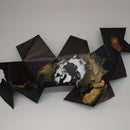Introduction: Frozen Tornadoes From Used Markers
This instructable will show you how to squeeze the last bits of color out of dried out markers, and make beautiful ice blocks in the process. This is a very kid friendly project that has many teachable moments which are highlighted by text in italics.
Step 1: STEP 1: Items
Nothing too sophisticated here:
- Some "dried-up" markers. Darker colors work better. Washable markers are safer to use with the little ones.
- Pliers
- An empty carton or other container (any shape will do).
- A clear bowl or jug
- Spoon
- 2 liters of warm water
Step 2: STEP 2: Remove the Ink Foam
Break the end off the marker with a wrenching motion with the pliers. Pull out the foam and applicator and deposit them in a clear bowl filled with warm water. Many reactions (dissolution and diffusion in this case) are faster at higher temperatures. Just let them soak for 5 minutes. If you are lucky, the ink seeps out of the foam bits and creates cool patterns in the water. Squeeze the remaining ink out of the foam with your fingers or a spoon. You can cut the foam into shorter lengths to speed the diffusion of the ink into the water. Increase of surface area increases the speed of any reactions.
Step 3: Step 3: Transfer and Freeze
After 10 minutes or so you will notice that the foam bits will get pale, or even white: good enough. Now transfer the solution into your container, leave it outside to freeze (or in the freezer). The shape of the colored portion will depend on the geometry of the "crystallization front". The warmer water will rise (thermal expansion), thus allowing the bottom to freeze first to produce the narrow end of the tornado. Depending on the climate I would allow at least 24 hours to ensure that it is frozen through.
To get the block out of the container, you can simply rip it apart with your bare hands and recycle it.
There are many interesting things going on here. The color is concentrated in the center of the ice block because the ink appears to prefer to stay as a liquid rather than within the ice crystals. Therefore the ink gets progressively concentrated in the remaining liquid until the temperature drops to the point that it also must crystallize. This process is called "Fractional Crystallization, and it is very common in earth systems: in magma chamber and seas (much of the world's deposits Iron, Titanium, Lithium were concentrated by this process). In fact, ice is considered by some as a mineral (like quartz or diamonds) and therefore liquid water is not unlike molten magma!
To get the block out of the container, you can simply rip it apart with your bare hands and recycle it.
There are many interesting things going on here. The color is concentrated in the center of the ice block because the ink appears to prefer to stay as a liquid rather than within the ice crystals. Therefore the ink gets progressively concentrated in the remaining liquid until the temperature drops to the point that it also must crystallize. This process is called "Fractional Crystallization, and it is very common in earth systems: in magma chamber and seas (much of the world's deposits Iron, Titanium, Lithium were concentrated by this process). In fact, ice is considered by some as a mineral (like quartz or diamonds) and therefore liquid water is not unlike molten magma!




